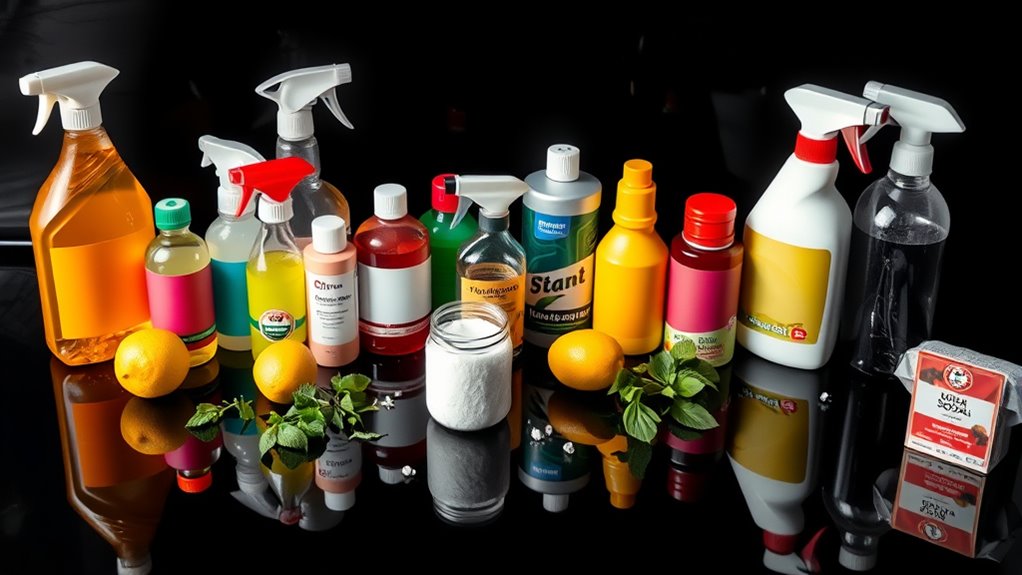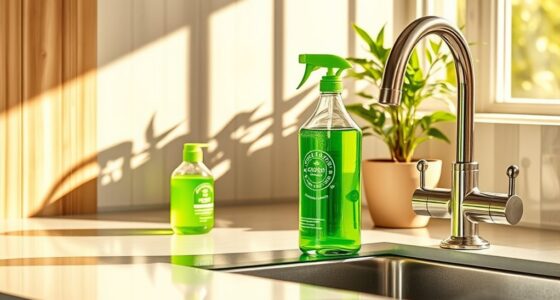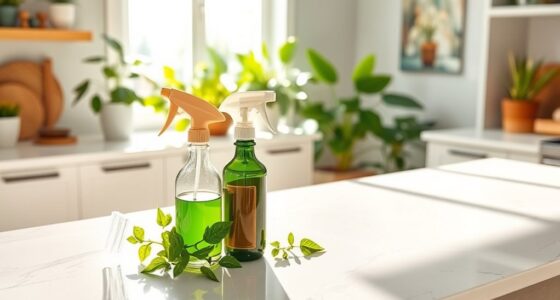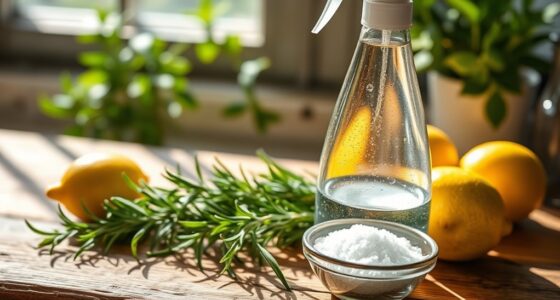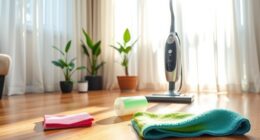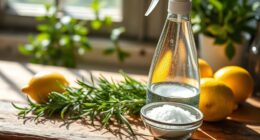When shopping for commercial cleaners, be wary of harmful ingredients. Avoid Nonylphenol Ethoxylates (NPEs), antibacterial solutions containing triclosan or triclocarban, and ammonia, which can irritate your respiratory system. Don’t forget to steer clear of Butyl Cellosolve, as it’s toxic to your internal organs. Finally, be cautious with Diethanolamine (DEA) and Triethanolamine (TEA), as they can form harmful chemicals. There’s more to discover about safer options, so keep exploring!
Key Takeaways
- Avoid Nonylphenol Ethoxylates (NPEs) as they disrupt endocrine systems and can increase breast cancer risks.
- Steer clear of antibacterial agents like triclosan and triclocarban, which can disrupt hormonal balance and contribute to antibiotic resistance.
- Do not use ammonia-based cleaners due to their respiratory irritation and the danger of toxic fumes when mixed with bleach.
- Refrain from products containing Butyl Cellosolve, as it poses significant health risks and can harm reproductive health.
- Limit exposure to Diethanolamine (DEA) and Triethanolamine (TEA) due to their potential to form harmful nitrosamines and cause skin irritation.
Nonylphenol Ethoxylates (NPEs)
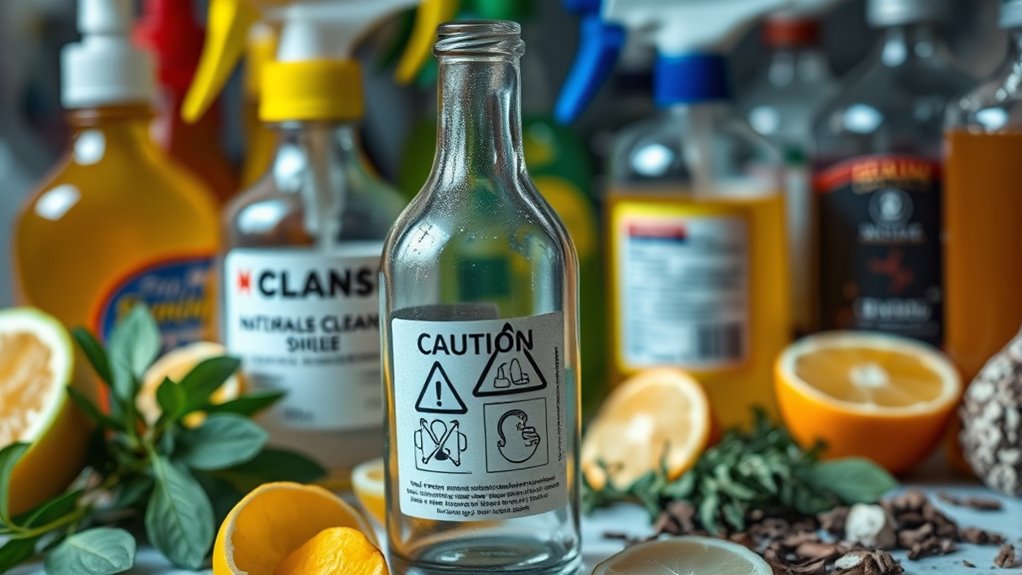
While you mightn’t think much about the ingredients in your cleaning products, Nonylphenol Ethoxylates (NPEs) are one you should definitely watch out for.
These toxic chemicals are commonly found in commercial cleaning products, enhancing their cleaning power but at a significant cost. NPEs break down into harmful compounds that disrupt endocrine systems, posing serious risks to wildlife and potentially affecting reproductive capacity in various species.
Toxic chemicals in cleaning products may boost effectiveness but threaten wildlife and disrupt endocrine systems. Choose wisely for a healthier planet.
Furthermore, studies have linked NPEs to increased breast cancer risks, making it vital for consumers to choose wisely. Many regions, including the European Union and California, have restricted or banned NPEs due to their environmental impact.
Opting for safer cleaning practices means avoiding products with these harmful ingredients, protecting both your health and the planet.
Antibacterial Solutions

Antibacterial solutions might seem like a smart choice for keeping your home germ-free, but they come with significant drawbacks.
Many commercial cleaners contain triclosan and triclocarban, which not only pose health risks but can also lead to the formation of carcinogenic chemicals when exposed to sunlight or water. Prolonged exposure to these antibacterial solutions can disrupt hormonal balance, impacting both human and animal health.
Additionally, their use contributes to the development of antibiotic-resistant bacteria, making infections harder to treat.
It’s essential to check for these toxic cleaning ingredients in your cleaning products, as the potential benefits of antibacterial solutions often don’t outweigh the associated health risks.
Choose wisely for a healthier home environment.
Ammonia
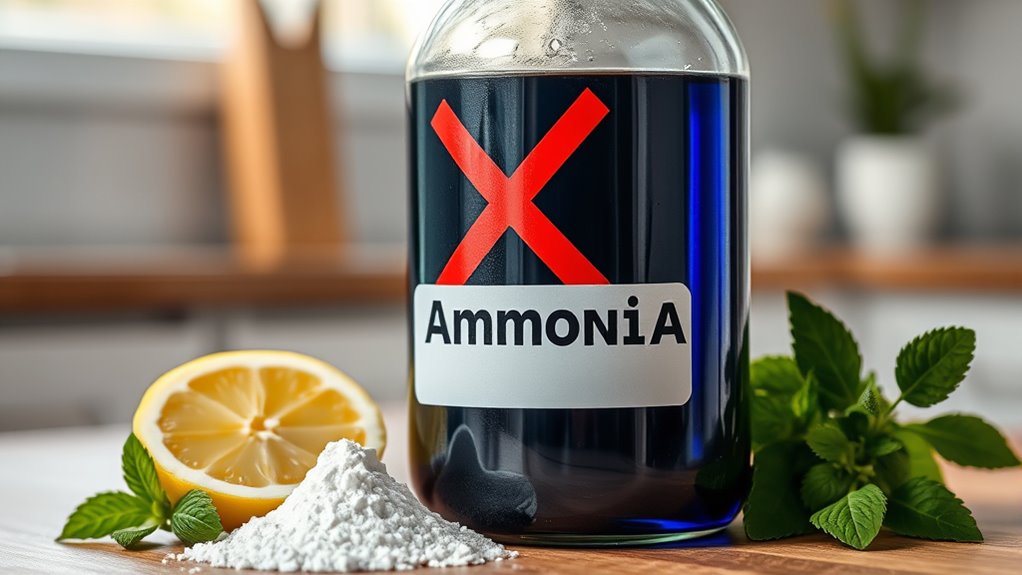
Although ammonia is often marketed as an effective cleaner, its strong odor and hazardous properties should raise red flags for consumers. This colorless gas is commonly found in household cleaners like glass cleaners, but its harmful ingredients can lead to respiratory irritation and eye damage.
Exposure to high concentrations can result in severe health risks, and mixing ammonia with bleach produces toxic fumes that are life-threatening. Given these dangers, it’s essential to scrutinize labels and avoid ammonia-based cleaning products.
Instead, opt for safe cleaning and eco-friendly options that protect both your health and the environment. By making informed choices, you can steer clear of hazardous chemicals and guarantee a safer cleaning experience.
Butyl Cellosolve
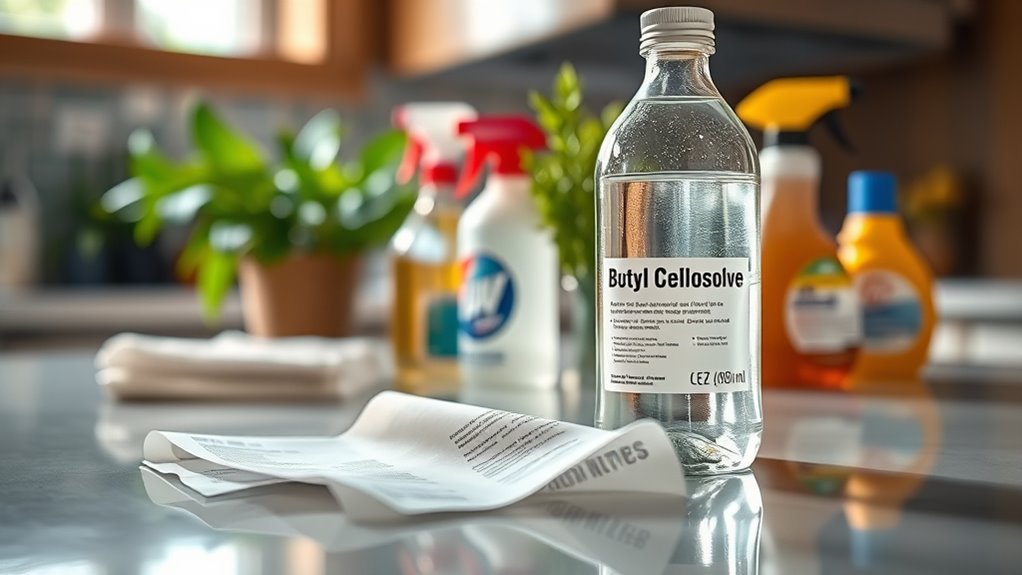
Butyl Cellosolve, a potent solvent often hiding in commercial cleaners, poses serious health risks that shouldn’t be ignored.
This harmful ingredient, also known as 2-Butoxyethanol, can irritate the eyes, skin, and respiratory system upon exposure. It’s toxic when ingested and can damage your liver and kidneys, raising significant concerns for user safety and environmental health.
Additionally, Butyl Cellosolve has been linked to potential reproductive toxicity, making it particularly concerning for pregnant individuals. Inhalation of its vapors may cause headaches, dizziness, and nausea, emphasizing the need for proper ventilation during use.
Thankfully, many manufacturers are now seeking safer cleaning alternatives, moving away from Butyl Cellosolve in response to rising awareness of its dangers.
Diethanolamine (DEA) and Triethanolamine (TEA)

Many commercial cleaners also contain Diethanolamine (DEA) and Triethanolamine (TEA), two ingredients commonly used as surfactants and pH balancers. However, these compounds can break down into harmful nitrosamines, raising significant safety concerns. Prolonged skin exposure may lead to irritation and absorption of these harmful chemicals into your bloodstream.
| Ingredient | Potential Risks | Recommendations |
|---|---|---|
| Diethanolamine (DEA) | Skin irritation, carcinogenic compounds | Avoid products containing DEA |
| Triethanolamine (TEA) | Respiratory issues, nitrosamines | Choose alternatives without TEA |
To minimize health risks, steer clear of cleaning products that list DEA and TEA. Your safety is worth it!
Frequently Asked Questions
Which of the Following Is an Ingredient to Avoid in Cleaning Products?
When choosing cleaning products, you should avoid certain ingredients that can pose health risks.
Ammonia irritates your respiratory system and can cause burns.
Bleach releases toxic fumes when mixed with acids, leading to respiratory issues.
Triclosan and triclocarban can disrupt hormones and contribute to antibiotic resistance.
Ultimately, phthalates are linked to reproductive health problems.
What Are the Harmful Chemicals in Floor Cleaners?
Did you know that over 20% of common floor cleaners contain harmful chemicals?
You’ve got to watch out for ingredients like ammonia, which can irritate your respiratory tract, and Butyl Cellosolve, known for its toxicity.
Diethanolamine and Triethanolamine can break down into carcinogenic compounds, while Naphthalene and Para Dichlorobenzene pose serious health risks.
Avoiding these harmful chemicals guarantees a safer cleaning experience for you and your environment.
Choose wisely!
How to Check if Cleaning Products Are Toxic?
To check if cleaning products are toxic, start by reading the ingredient labels carefully.
Look for known harmful substances like ammonia and phthalates. Seek out certifications like Green Seal to guarantee safety standards are met.
Don’t shy away from researching complex or unfamiliar ingredients to understand their risks. Be wary of vague terms like “fragrance,” as they might conceal harmful additives.
Finally, use resources like the Environmental Working Group to find safety ratings.
What Cleaning Products Have High VOCS?
When it comes to cleaning products, you should steer clear of those notorious for high VOCs.
Aerosol sprays, air fresheners, and certain disinfectants often release harmful fumes that can harm your health.
Look for labels that mention “fragrance” or “parfum,” as they frequently hide dangerous chemicals.
To protect your indoor air quality, always opt for low-VOC or VOC-free products, and make sure to ventilate your space while you clean.
Conclusion
When you choose commercial cleaners, it’s essential to be aware of harmful ingredients like NPEs, ammonia, and DEA. These chemicals not only pose risks to your health but can also harm the environment. By opting for safer alternatives, you can clean effectively without compromising your well-being. Isn’t it worth investing a little time to understand what’s in your cleaning products? Making informed choices empowers you to create a healthier home for yourself and your family.

